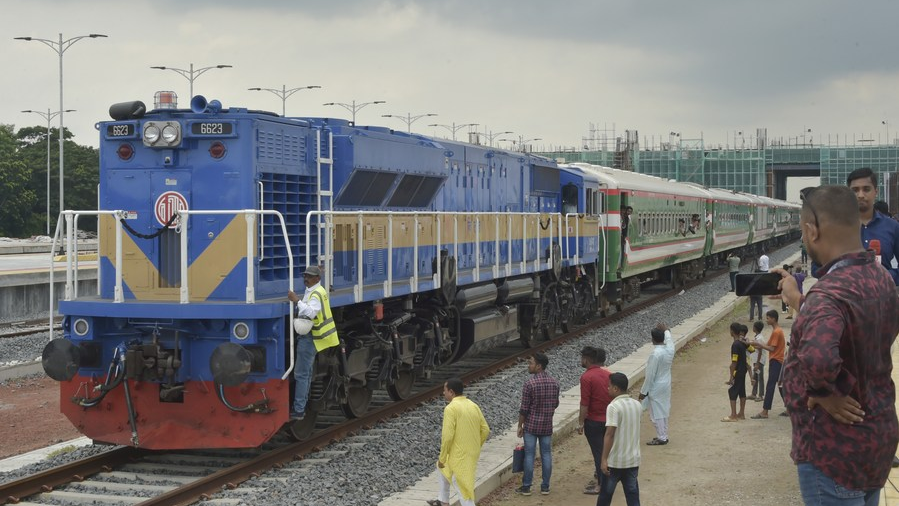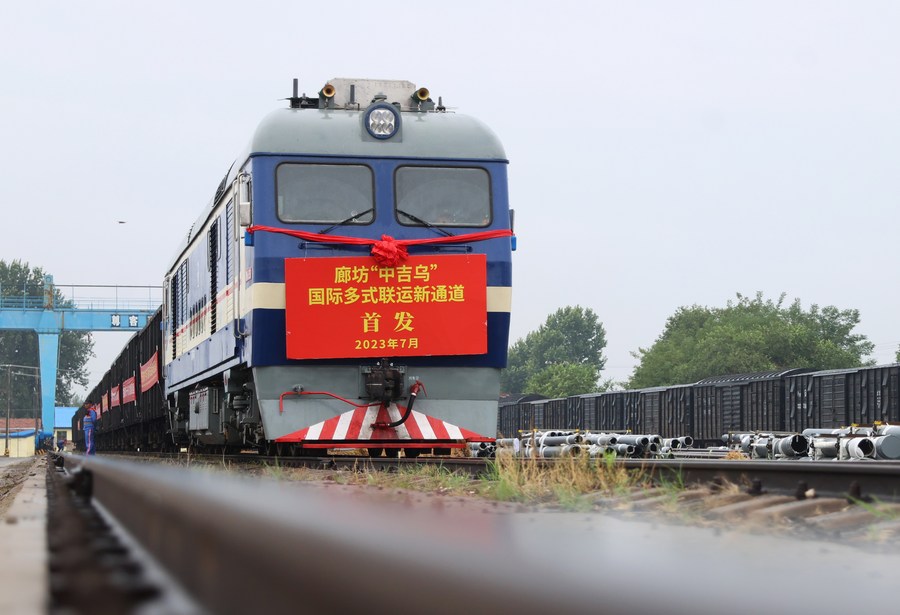
A man takes photos of a train ready for a trial run along the newly-constructed mega Belt and Road Initiative (BRI) rail line via Bangladesh's largest Padma Bridge on the outskirts of Dhaka, Bangladesh, September 7, 2023. /Xinhua
A man takes photos of a train ready for a trial run along the newly-constructed mega Belt and Road Initiative (BRI) rail line via Bangladesh's largest Padma Bridge on the outskirts of Dhaka, Bangladesh, September 7, 2023. /Xinhua
The Belt and Road Initiative (BRI) is injecting positive energy into world peace and development, said a white paper released by China's State Council Information Office on Tuesday.
The white paper, titled "The Belt and Road Initiative: A Key Pillar of the Global Community of Shared Future," said against a rising tide of de-globalization, the BRI is committed to global connectivity and interconnected development.
"By expanding economic globalization and distributing its benefits fairly, the BRI aims to promote global development that is balanced, coordinated, inclusive and shared by all, and that brings win-win cooperation and common prosperity," the white paper said.
The BRI has connected the vibrant East Asia economic circle at one end, the developed European economic circle at the other, and the countries in between with huge potential for economic development, and fostered closer economic cooperation with African and Latin American countries, according to the white paper.
Efforts have been made to promote global trade, according to the white paper. The BRI has eliminated internal, transnational, and inter-regional transport bottlenecks and barriers to trade and investment cooperation, made cross-border logistics and foreign trade easier and more convenient, and increased the efficiency of domestic and international cooperation.
The BRI has made participating countries more attractive to quality global capital, the white paper said. Direct cross-border investment in Southeast Asia, Central Asia and other regions has risen steadily. In 2022, cross-border direct investment inflows in Southeast Asia accounted for 17.2 percent of the global total, 9 percentage points higher than in 2013.

The first train of a new international multimodal transport route departs from Langfang City, north China's Hebei Province, July 4, 2023. /Xinhua
The first train of a new international multimodal transport route departs from Langfang City, north China's Hebei Province, July 4, 2023. /Xinhua
Tangible benefits
The BRI has been boosting development in participating countries, said the white paper.
A large number of infrastructure projects have been built, with significant progress for participating countries in the construction of railways, highways, pipelines, shipping, energy, communications and other basic public service facilities, according to the white paper.
"Some engineering projects with a long construction cycle are like seeds sown in a field, gradually generating comprehensive benefits for the long term," it said.
In building poverty reduction capacity in participating countries, China has taken an active part in global food and agriculture governance as developing countries still face the challenge of problems related to food.
More than 2,000 agricultural experts and technicians have been sent to over 70 countries and regions, and more than 1,500 agricultural technologies such as Juncao and hybrid rice have been introduced to many of these countries, according to the white paper.
It noted that China's trade in agricultural products with BRI partners has reached $139.4 billion.
Aiming to boost employment, China has helped to construct industrial parks with participating countries and provided guidance for Chinese enterprises to create jobs for local residents through high-level industrial cooperation in the process of BRI cooperation, according to the white paper.
Notable results in projects have been achieved in improving people's lives. Over the past 10 years, Chinese firms have launched more than 300 poverty alleviation, health care and rehabilitation, and Happy Home projects in participating countries, according to the white paper.